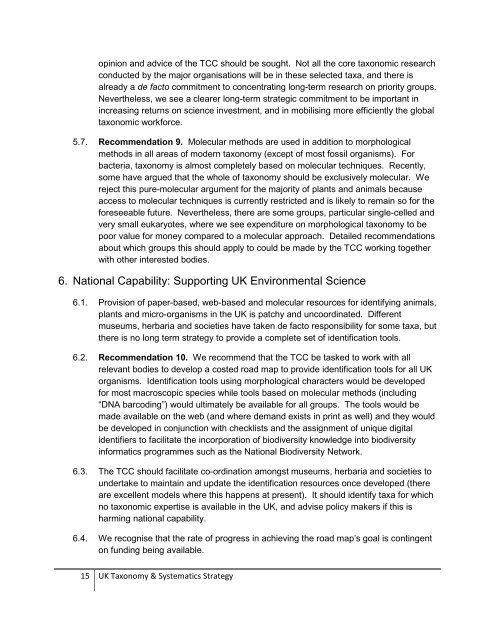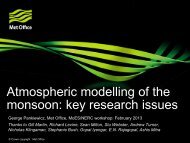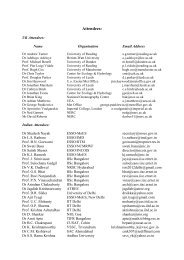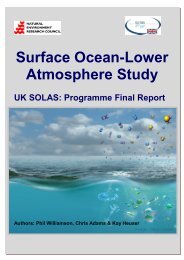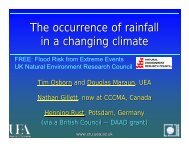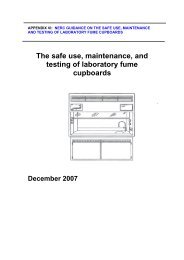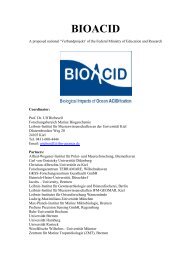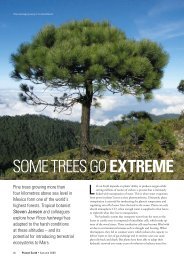Developing a National Strategy in Taxonomy & Systematics (168KB)
Developing a National Strategy in Taxonomy & Systematics (168KB)
Developing a National Strategy in Taxonomy & Systematics (168KB)
Create successful ePaper yourself
Turn your PDF publications into a flip-book with our unique Google optimized e-Paper software.
op<strong>in</strong>ion and advice of the TCC should be sought. Not all the core taxonomic research<br />
conducted by the major organisations will be <strong>in</strong> these selected taxa, and there is<br />
already a de facto commitment to concentrat<strong>in</strong>g long-term research on priority groups.<br />
Nevertheless, we see a clearer long-term strategic commitment to be important <strong>in</strong><br />
<strong>in</strong>creas<strong>in</strong>g returns on science <strong>in</strong>vestment, and <strong>in</strong> mobilis<strong>in</strong>g more efficiently the global<br />
taxonomic workforce.<br />
5.7. Recommendation 9. Molecular methods are used <strong>in</strong> addition to morphological<br />
methods <strong>in</strong> all areas of modern taxonomy (except of most fossil organisms). For<br />
bacteria, taxonomy is almost completely based on molecular techniques. Recently,<br />
some have argued that the whole of taxonomy should be exclusively molecular. We<br />
reject this pure-molecular argument for the majority of plants and animals because<br />
access to molecular techniques is currently restricted and is likely to rema<strong>in</strong> so for the<br />
foreseeable future. Nevertheless, there are some groups, particular s<strong>in</strong>gle-celled and<br />
very small eukaryotes, where we see expenditure on morphological taxonomy to be<br />
poor value for money compared to a molecular approach. Detailed recommendations<br />
about which groups this should apply to could be made by the TCC work<strong>in</strong>g together<br />
with other <strong>in</strong>terested bodies.<br />
6. <strong>National</strong> Capability: Support<strong>in</strong>g UK Environmental Science<br />
6.1. Provision of paper-based, web-based and molecular resources for identify<strong>in</strong>g animals,<br />
plants and micro-organisms <strong>in</strong> the UK is patchy and uncoord<strong>in</strong>ated. Different<br />
museums, herbaria and societies have taken de facto responsibility for some taxa, but<br />
there is no long term strategy to provide a complete set of identification tools.<br />
6.2. Recommendation 10. We recommend that the TCC be tasked to work with all<br />
relevant bodies to develop a costed road map to provide identification tools for all UK<br />
organisms. Identification tools us<strong>in</strong>g morphological characters would be developed<br />
for most macroscopic species while tools based on molecular methods (<strong>in</strong>clud<strong>in</strong>g<br />
“DNA barcod<strong>in</strong>g”) would ultimately be available for all groups. The tools would be<br />
made available on the web (and where demand exists <strong>in</strong> pr<strong>in</strong>t as well) and they would<br />
be developed <strong>in</strong> conjunction with checklists and the assignment of unique digital<br />
identifiers to facilitate the <strong>in</strong>corporation of biodiversity knowledge <strong>in</strong>to biodiversity<br />
<strong>in</strong>formatics programmes such as the <strong>National</strong> Biodiversity Network.<br />
6.3. The TCC should facilitate co-ord<strong>in</strong>ation amongst museums, herbaria and societies to<br />
undertake to ma<strong>in</strong>ta<strong>in</strong> and update the identification resources once developed (there<br />
are excellent models where this happens at present). It should identify taxa for which<br />
no taxonomic expertise is available <strong>in</strong> the UK, and advise policy makers if this is<br />
harm<strong>in</strong>g national capability.<br />
6.4. We recognise that the rate of progress <strong>in</strong> achiev<strong>in</strong>g the road map’s goal is cont<strong>in</strong>gent<br />
on fund<strong>in</strong>g be<strong>in</strong>g available.<br />
15 UK <strong>Taxonomy</strong> & <strong>Systematics</strong> <strong>Strategy</strong>


